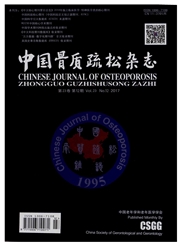

 中文摘要:
中文摘要:
目的探讨膝关节骨关节炎(osteoarthritis,OA)患者血液和滑液MMP-3水平与其病变严重程度的关系。方法随机选取33例膝关节OA患者[男20例,女13例;年龄55~87岁,平均(65.8±6.8)岁]和15名健康对照者[男9例,女6例;年龄53~83岁,平均(62.3±7.2)岁]作为研究对象。采用Kellgren-Lawrence标准进行放射学分级,酶联免疫吸附法(ELISA)测定关节血液和滑液MMP-3水平。结果OA患者与对照者相比,关节血液MMP-3水平(178.61±83.82):(73.264-21.51)ng/ml和滑液MMP-3水平(5612.31±3013.93):(782.63±426.22)ng/ml均明显升高。关节血液和滑液MMP-3水平均与OA病变严重程度(KL分级)呈正相关(r=0.627,P〈0.001;r=0.55,P=0.001)。关节血液MMP-3水平与滑液MMP-3水平呈正相关(r=0.509,P=0.002)。结论OA患者血液和滑液MMP-3水平都与病变严重程度相关。因此,MMP-3在OA的病理过程中起关键作用,并且可以作为OA病变严重程度的生物标记。
 英文摘要:
英文摘要:
Objective To investigate the correlation between MMP-3 levels in blood and synovial fluid and the severity of primary knee osteoarthritis (OA). Methods A total of 33 patients with knee OA and 15 healthy controls were enrolled in this study. There were 20 men and 13 women, whose age ranged from 55 to 87 years old, with an average age of 65.8 -± 6.8 years old, in OA group. The control group included 9 men and 6 women, whose age ranged from 53 to 83 years old, with an average age of 62. 3 ± 7.2 years old. The radiographic grading of the knee was performed according to Kellgren-Lawrence criteria. MMP-3 levels in blood and synovial fluid were measured using enzyme-linked immunosorbent assay (ELISA). Results Compared to healthy controls, the knee OA patients had higher MMP-3 concentrations in blood ( 178.61 ± 83.82 vs. 73.26 ± 21.51 ng/ml) and synovlal fluid (5612.31 ± 3013.93 vs. 782.63 ± 426.22 ng/ml). In addition, plasma and synovial fluid MMP -3 concentrations displayed significant and positive correlation with radiographic severity (r = 0. 627, P 〈 0. 001 ; r = 0. 551, P = 0. 001 ). Subsequent analysis revealed that there was a positive correlation between blood and synovial fluid IL-18 levels (r = 0. 509, P = 0. 002). Conclusion The data reveal that MMP-3 in both blood and synovial fluid is related to the disease severity of OA. Thus, MMP-3 plays an important role in the pathological process of OA, and it can be used as a biomarker to prediet the disease severity of OA.
 同期刊论文项目
同期刊论文项目
 同项目期刊论文
同项目期刊论文
 O-GlcNAc glycosylation of p27(kip1) promotes astrocyte migration and functional recovery after spina
O-GlcNAc glycosylation of p27(kip1) promotes astrocyte migration and functional recovery after spina TCTP Expression After Rat Spinal Cord Injury: Implications for Astrocyte Proliferation and Migration
TCTP Expression After Rat Spinal Cord Injury: Implications for Astrocyte Proliferation and Migration 期刊信息
期刊信息
